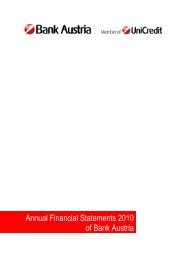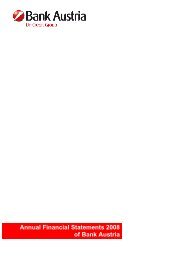Annual Financial Statements 2011 of Bank Austria
Annual Financial Statements 2011 of Bank Austria
Annual Financial Statements 2011 of Bank Austria
Create successful ePaper yourself
Turn your PDF publications into a flip-book with our unique Google optimized e-Paper software.
Consolidated <strong>Financial</strong> <strong>Statements</strong> in accordance with IFRSs<br />
D – Segment reporting (CoNTINuED)<br />
D.2 – Description <strong>of</strong> segment reporting<br />
The segment reporting format is based on the internal reporting structure <strong>of</strong> business segments, which reflects management responsibilities in the<br />
<strong>Bank</strong> <strong>Austria</strong> Group in <strong>2011</strong>. The business segments are presented as independent units with their own capital resources and responsibility for their<br />
own results. This also meets the requirements <strong>of</strong> IFRS 8.<br />
Starting with the reporting period in <strong>2011</strong>, segment reporting was adjusted to the new structure <strong>of</strong> the Group’s income statement. Goodwill impairment<br />
and the Purchase Price Allocation effect are now shown immediately before net pr<strong>of</strong>it attributable to the owners <strong>of</strong> <strong>Bank</strong> <strong>Austria</strong>.<br />
The definition <strong>of</strong> business segments is primarily based on organisational responsibility for customers.<br />
Family & SME <strong>Bank</strong>ing<br />
Responsibility for the Family & SME <strong>Bank</strong>ing segment covers <strong>Bank</strong> <strong>Austria</strong>’s business with private customers (except Private <strong>Bank</strong>ing customers) and<br />
small and medium-sized enterprises (SMEs) with a turnover <strong>of</strong> up to € 50 m. Also included in this Division are the credit card business and factoring<br />
business.<br />
Private <strong>Bank</strong>ing<br />
Private <strong>Bank</strong>ing has responsibility for private customers with investments exceeding € 500,000. Schoellerbank AG and various other small subsidiaries<br />
are also included in the Private <strong>Bank</strong>ing Division.<br />
Corporate & Investment <strong>Bank</strong>ing<br />
The Corporate & Investment <strong>Bank</strong>ing segment covers the product lines Financing & Advisory (classic and structured lending business and capital market<br />
advisory services), Global Transaction <strong>Bank</strong>ing (including payment transactions, trade finance, cash management) and Markets (Treasury). Control is<br />
performed through a matrix organisation based on customer segments: international corporates, corporate customers whose turnover exceeds € 50 m,<br />
real estate, public sector and financial institutions.<br />
The Corporate & Investment <strong>Bank</strong>ing segment includes a number <strong>of</strong> subsidiaries – e.g. the <strong>Bank</strong> <strong>Austria</strong> Real Invest Group, <strong>Bank</strong> <strong>Austria</strong> Wohnbau-<br />
bank AG and smaller subsidiaries in CEE countries with a focus on investment banking – as consolidated companies.<br />
Central Eastern Europe (CEE)<br />
The CEE business segment includes the commercial banking units <strong>of</strong> the <strong>Bank</strong> <strong>Austria</strong> Group in the region <strong>of</strong> Central and Eastern Europe (including<br />
Turkey and Kazakhstan).<br />
Corporate Center<br />
The Corporate Center comprises all equity interests that are not assigned to other segments and it also includes the contribution from UniCredit<br />
Leasing, in which <strong>Bank</strong> <strong>Austria</strong> has a shareholding interest <strong>of</strong> 31.01% accounted for under the equity method. Funding costs relating to consolidated<br />
subsidiaries and equity not allocated to business segments are also assigned to the Corporate Center. Also included are inter-segment eliminations,<br />
other items which are not to be assigned to other business segments, and impairment losses on goodwill.<br />
Methods<br />
Net interest is split up according to the market interest rate method. Costs are allocated to the individual business segments from which they arise.<br />
The result <strong>of</strong> each business segment is measured by the pr<strong>of</strong>it earned by the respective segment.<br />
The interest rate applied to investment <strong>of</strong> equity allocated to the business segments is determined for one year in advance as part <strong>of</strong> the budgeting<br />
process. It is composed <strong>of</strong> a “risk-free” interest rate plus a margin <strong>of</strong> the historical average (6 years) <strong>of</strong> the 5-year CDS spread <strong>of</strong> UniCredit.<br />
Overhead costs are allocated to the business segments according to a key <strong>of</strong> distribution applied within the Group on a uniform basis (50% costs,<br />
20% revenues, 20% FTEs and 10% proportionately).<br />
In <strong>2011</strong>, capital allocated to the business segments in UniCredit <strong>Bank</strong> <strong>Austria</strong> AG, based on the Tier 1 capital ratio, is 7% <strong>of</strong> risk-weighted assets <strong>of</strong><br />
the preceding quarter. Capital allocation to subsidiaries reflects actual IFRS capital. The adjustment item with respect to the consolidated IFRS capital<br />
<strong>of</strong> the <strong>Bank</strong> <strong>Austria</strong> Group is reflected in the Corporate Center.<br />
<strong>Bank</strong> <strong>Austria</strong> · <strong>Annual</strong> <strong>Financial</strong> <strong>Statements</strong> <strong>2011</strong><br />
126
















